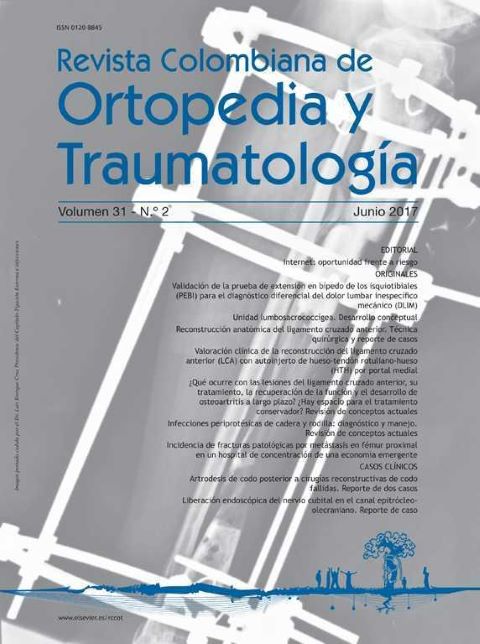Clinical validation of Hamstring Biped Extension Test for the differential diagnosis of mechanical origin low back pain (MLBP)
DOI:
https://doi.org/10.1016/j.rccot.2017.03.001Keywords:
mechanical origin low back pain, semiology, clinical sign, low back painAbstract
Background: Mechanical origin low back pain (MLBP) is the leading cause of work disability and the largest generator of direct and indirect care costs of any health system. There is no medical test to diagnose MLBP, although a test was designed in 2004 for the clinical diagnosis of MLBP.
Materials and methods: A prospective cohort study was conducted on 183 patients with nonradicular back pain and had a positive Hamstring Biped Extension Test (HBET) from 2004 to 2014. All (100%) of the patients included in the cohort were rehabilitated using the McKenzie protocol until the pain disappeared, or the patients were unable to improve their rehabilitation process. Additionally, the presence of related anatomical pain generating factors was assessed using various diagnostic imaging tests (MRI, scintigraphy, etc.).
Results: All patients had a positive HBET when they were included in the cohort. All had diagnostic imaging performed. The pain measured on a visual analogue scale (VAS) had a mean of 7.7 (range 2-10/10). There was a mean follow-up time of 2.24 months (range 1-6 months), with a mean of 20.94 (range 10-60) physiotherapy sessions. A negative result was obtained for the HBET in 100% of patients (P = .05). There was a mean improvement of 0.84 (range 0-3/10, P = .05) on the VAS pain measurement at discharge.
Discussion: The HBET is a useful clinical test for the diagnosis of MLBP, with a positive predictive value of 100%. Low back pain was not associated with diagnostic image tests findings in our cohort in the presence of a positive HBET.
Evidence level: II.
Downloads
References
Thiese MS, Hegmann KT, Wood EM, Garg A, Moore JS, Kapellusch J, et al. Prevalence of low back pain by anatomic location and intensity in an occupational population. BMC Musculoskelet Disord. 2014;15:283. https://doi.org/10.1186/1471-2474-15-283
Koes B, Tulder M, Lin C, Macedo L, McAuley J, Maher C. An updated overview of clinical guidelines for the management of non-specific low back pain in primary care. Eur Spine J. 2010;19:2075-94. https://doi.org/10.1007/s00586-010-1502-y
Savigny P, Kuntze S, Watson P, Underwood M, Ritchie G, Cotterell M, et al. Low back pain: early management of persistent nonspecific low back pain. London: National Collaborating Centre for Primary Care and Royal College of General Practitioners; 2009.
Franke H, Franke J, Fryer G. Osteopathic manipulative treatment for nonspecific low back pain: a systematic review and meta-analysis. BMC Musculoskelet Disord. 2014;15:286-313. https://doi.org/10.1186/1471-2474-15-286
Hidalgo B, Nielens H, Gilliaux M. Use of kinematic algorithms to distinguish people with chronic non-specific low back pain from asymptomatic subjects: a validation study. J Rehabil Med. 2014;46:819-23. https://doi.org/10.2340/16501977-1836
Nakipo˘glu GF, Karagöz A, Ozgirgin N. The biomechanics of the lumbosacral region in acute and chronic low back pain patients. Pain Physician. 2008;11:505-11. https://doi.org/10.36076/ppj.2008/11/505
Croft PR, Macfarlane GJ, Papageorgiou AC, Thomas E, Silman AJ. Outcome of low back pain in general practice: a prospective study. BMJ. 1998;316:1356-9. https://doi.org/10.1136/bmj.316.7141.1356
Garcia AN, Costa Lda C, Hancock MJ, de Almeida MO, de Souza FS, Costa LO. Efficacy of the McKenzie method in patients with chronic nonspecific low back pain: a protocol of randomized placebo-controlled trial. Phys Ther. 2015;95:267-73. https://doi.org/10.2522/ptj.20140208
Hartvigsen L, Kongsted A, Hestbaek L. Clinical examination findings as prognostic factors in low back pain: a systematic review of the literature. Chiropr Man Therap. 2015;23:13-34. https://doi.org/10.1186/s12998-015-0054-y
Savage RA, Whitehouse GH, Roberts N. The relationship between the magnetic resonance imaging appearance of the lumbar spine and low back pain, age and occupation in males. Eur Spine J. 1997;6:106-14. https://doi.org/10.1007/BF01358742
Herrera J. Artroplastia de tobillo. Estado del arte. Rev Col Or Tra. 2008;22:247-60.
Suri P, Boyko E, Goldberg J, Forsberg C, Jarvik J. Longitudinal associations between incident lumbar spine MRI findings and chronic low back pain or radicular symptoms: retrospective analysis of data from the longitudinal assessment of imaging and disability of the back (LAIDBACK). BMC Musculoskelet Disord. 2014;15:152. https://doi.org/10.1186/1471-2474-15-152
McGregor AH, McCarthy ID, Doré CJ, Hughes SP. Quantitative assessment of the motion of the lumbar spine in the low back pain population and the effect of different spinal pathologies on this motion. Eur Spine J. 1997;6:308-15. https://doi.org/10.1007/BF01142676
Downloads
Published
How to Cite
Issue
Section
License
Copyright (c) 2024 Revista Colombiana de ortopedia y traumatología

This work is licensed under a Creative Commons Attribution 3.0 Unported License.




